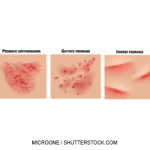On Day 4 in the hospital, the patient is transferred to another facility to continue therapy under the direct care of his dermatologist. The anasarca has lessened, and his lactic acidosis and acute kidney injury have resolved. Blood cultures are negative, and the generalized fiery red rash has significantly improved.
There is disagreement on the epidemiology of psoriasis, but a recent meta-analysis concluded the adult prevalence in the U.S. ranges from 2.2–3.15%.4 Erythrodermic psoriasis is estimated to affect between 1.0 and 2.25% of those who have psoriasis.5 While erythrodermic psoriasis can be associated with a high risk of deterioration and mortality due to secondary infection and sepsis, there are no data on mortality rates, due to the overall low incidence of erythrodermic psoriasis flares.5
Jared H. Brock, BS, is a medical student at the University of Arizona College of Medicine in Tucson.
Blaine M. Hannafin, MD, RDMS, is in the department of emergency medicine at Chandler Regional Medical Center in Chandler, Ariz.
Frank Lovecchio, DO, MPH, is vice chair and research director at the Maricopa Medical Center in Phoenix and professor of emergency medicine, pharmacology and medicine at the University of Arizona College of Medicine.
References
- Boyd AS, Menter A. Erythrodermicpsoriasis: Precipitating factors, course, and prognosis in 50 patients. J Am Acad Dermatol. 1989 Nov;21(5 Pt 1):985–991.
- Rosenbach M, Hsu S, Korman NJ, et al. Treatment of erythrodermic psoriasis: From the Medical Board of the National Psoriasis Foundation. J Am Acad Dermatol. 2010 Apr;62(4)655–662.
- Green MS, Prystowsky JH, Cohen SR, et al. Infectious complications of erythrodermic psoriasis. J Am Acad Dermatol. 1996 May;34(5 Pt 2):911–914.
- Parisi R, Symmons DP, Griffiths EC, et al. Global epidemiology of psoriasis: A systematic review of incidence and prevalence. J Invest Dermatol. 2013 Feb;133(2):377–385.
- Koo JY, Levin EC, Leon A, et al. Moderate to Severe Psoriasis, fourth ed. CRC Press. 2014.
Note: Reprinted with permission from ACEP Now, September 2014, p. 19.

